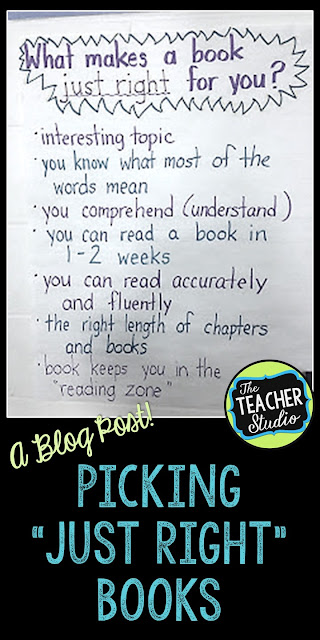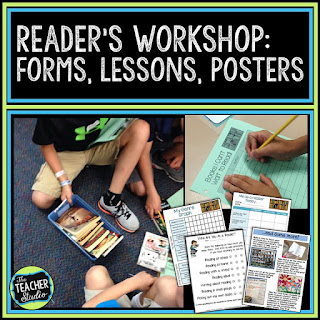Some things just need repeating, and I am starting to see a few of my fourth graders slipping in their ability to make “just right” books choices. You know the students…reading Magic Tree House one day and then trying to pick up a copy of Percy Jackson the next?
To start the year, we spent a great deal of time building a reading community, talking about how to select a book, what a “just right” book is, and so on. That being said, as students’ abilities change, they sometimes need a little “reminder” about what it is we are trying to accomplish! So…on the “to do” list for tomorrow is to go revisit the anchor chart we made back in September…
…and to make sure we do some reflecting on what makes a book “just right” –for THEM. I think we will then spend some time re-exploring our classroom library so students can make a new list of books they can’t wait to read–I always like students to have some ideas about what their next few books are so they don’t waste time aimlessly looking! Hopefully, students can find some hidden gems in my bins and on my shelves!
How much independent reading should my students do?
I have had some teachers ask about a few things on my list. Why “read a book in 1-2 weeks”? This one is an interesting one…because I have a TON of students reading books like Percy Jackson and Harry Potter. My belief is that for MOST students, getting a book finished in 2 weeks is reasonable…if they are given 30-40 minutes of reading at school and also are reading at home. If they ARE NOT reading for that much time, it might make sense to read shorter books. Why? Deep understanding is much harder if you are reading a book for weeks and weeks because you lose elements from the early chapters. I often do the math with my students. If a book is 400 pages, and they want to read it in two weeks, we simply take the 400 and divide by 14. It’s about 29 pages a day–VERY reasonable for a reading session at school and home. If a child is only reading 5-6 pages a day, I think we can all agree that they are not fully immersed in the text or in the “reading zone”. If students REALLY want to read those longer texts, I ask them to really commit to them. Let’s be honest, some students simply aren’t ready for that–and THAT IS OK!
Is the 5 Finger Rule Valid?
Another question teachers sometimes ask me is about the classic “five finger rule”. I talk to my students about this at length…if a child doesn’t know five words on a page (especially if the book doesn’t have that many words per page!), I firmly believe that book is too challenging. We may use texts that challenging for INSTRUCTION, but if the text is meant to be independent, I don’t think students should have to work that hard decoding…they should be focused on comprehension. We use the “two finger rule” instead, and I really try to help my students understand why this matters–and how it can make their reading so much more enjoyable. Reading shouldn’t be THAT hard if we want them to enjoy it! Save the struggle for when we are there to coach them.
How I keep reviewing independent reading strategies all year long
It’s never a bad idea to review some of these things throughout the year to keep students focused. What are some of those ongoing things I do?
- I do frequent “book talks” all year to keep students thinking about the types of books that might be interesting to them.
- I take “status of the class” daily so I always know what students are reading and I can help them self-monitor and make good choices. (Click HERE to see how I keep track of all this!)
- I am constantly looking to add new books to my collection.
- I ask students who have completed books that I haven’t read to tell the class a little about it so they can “sell” it to students who might also enjoy it.
- I am very deliberate with my read alouds to help “hook” kids on books, authors, and series.
- I continue to build anchor charts to display that we refer to often.
- I work hard to make sure students understand that reading isn’t a race–and what makes a book “just right” for one student might not make it just right for another.
(If you are interested in some of the things I do to get my reader’s workshop and reading “behaviors” established…check out this resource.)






